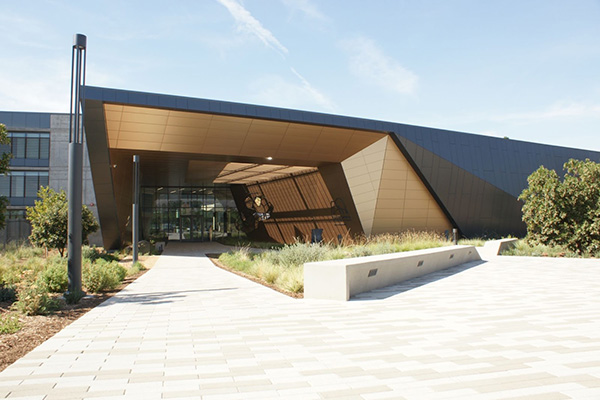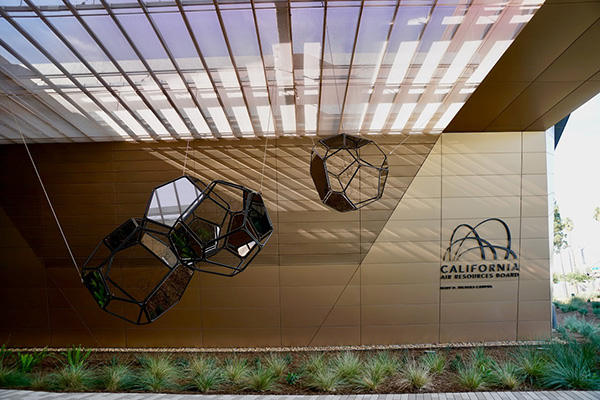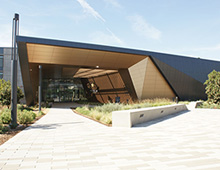CARB Set to Usher In New Era of Transportation From Riverside
Published: 10/22/2021

The main public entrance to CARB’s Southern California headquarters shows the signature auditorium building. Courtesy CARB.
The California Air Resources Board (CARB) recently opened the doors of its relocated Southern California headquarters bringing together the latest in modern green architecture under one solar-powered roof. The structure is a 20-year effort to replace an aging facility and an opportunity to design a building that represents what the government agency sees for the future.
“Much credit goes to our past Chairwoman Mary Nichols who was looking for land that came with possibilities,” said John Swanton, air pollution specialist who has been with CARB for 25 years.
A decision to build the CARB facility in Riverside is based on the advantages of being next to the University of California Riverside (UCR) campus and anchoring the city’s Innovation District. CARB chose Riverside in March 2016 after deciding the land owned by the University of California on Iowa Avenue would provide the best opportunity for growth in the coming decades.

Front entrance with sculpture by Tomás Saraceno. Courtesy CARB.
The fight against smog in Southern California was the impetus for CARB forming in 1967. The board went on to set groundbreaking pollution standards for cars and trucks. As CARB moves into more advanced areas of pollution control and navigating highly complex climate-changing gases, Swanton said there is no time to waste.
“Anything that can be done to make our work more rapid and effective positions us to continue leading urgent action to advocate for healthy air,” Swanton said.
Perhaps the greatest feature of CARB’s new facility is its open floor plan built to foster collaboration in a field that benefits from a range of opinions and experiences. Testing and technical work can be observed from almost anywhere in the space.

A large pick-up truck is tested by CARB staff and the equipment manufacturer to validate the new vehicle laboratory equipment and installation. Courtesy CARB.
At the heart of the 19-acre build is CARB’s motor vehicle and engine emissions testing and research lab — a key function of the organization for 50 years. The structure is on track to be the single largest net-zero energy laboratory in the nation, meaning it will produce as much energy as it uses. The facility is also built to LEED Platinum and CalGreen Tier 2 standards, the highest certifications in California. In total, construction cost the board roughly $419M with funding from various sources including a Volkswagen settlement for air quality violations and the Air Pollution Control Fund.
“It’s a privilege to have one of the world’s largest and most advanced testing and research facilities in our backyard, driving collaboration between UCR, CARB, and the startups who want to be near the forefront of climate leadership and innovation,” said, Councilmember Cervantes. “We’re grateful for the hundreds of high-tech, high-paying green jobs CARB will bring to the region and look forward to supporting the board’s continued success.”

Courtyard with sculpture by Allora & Calzadilla. Courtesy CARB.
As California is plagued by wildfires, drought, and changing climate, CARB stands as an example of the progress that is still possible: A new era of transportation to promote a cleaner future.
“Check back in 10 years and we’ll likely be testing a majority of electric cars,” Swanton said. “We’re excited to be embedded in the Riverside community to help us meet the moment for the next crucial decade of pollution-fighting and next-generation vehicles.”
For information about CARB, go to WW2.ARB.CA.GOV.


